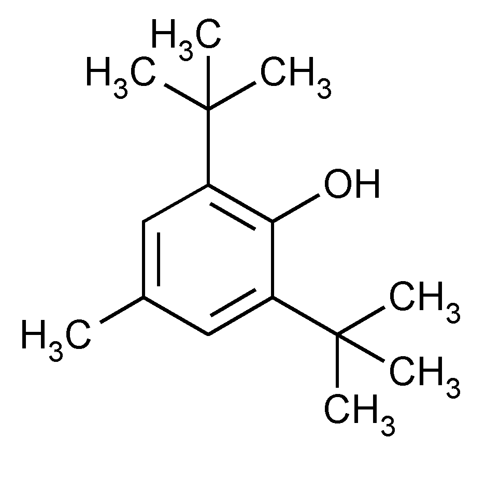Butylated Hydroxytoluene
» Butylated Hydroxytoluene contains not less than 99.0 percent of C15H24O.
Butylated Hydroxytoluene contains not less than 99.0 percent of C15H24O.
Packaging and storage—
Preserve in well-closed containers.
Residue on ignition  281
281 —
Transfer about 50 g, accurately weighed, to a tared crucible, ignite until thoroughly charred, and cool. Moisten the ash with 1 mL of sulfuric acid, and complete the ignition by heating at 800 ± 25
—
Transfer about 50 g, accurately weighed, to a tared crucible, ignite until thoroughly charred, and cool. Moisten the ash with 1 mL of sulfuric acid, and complete the ignition by heating at 800 ± 25 for 15-minute periods to constant weight: the limit is 0.002%.
for 15-minute periods to constant weight: the limit is 0.002%.
Heavy metals, Method II  231
231 :
0.001%.
:
0.001%.
Add the following:
Potassium ferricyanide solution—
Dissolve 50 mg of potassium ferricyanide in water to 10 mL.
Ferric chloride solution—
Dissolve 105 mg of ferric chloride in water to 10 mL.
Adsorbent:
0.25-mm layer of chromatographic silica gel mixture.
Test solution—
Dissolve an accurately weighed quantity of Butylated Hydroxytoluene in methanol to obtain a solution having a concentration of about 20 mg per mL.
Reference solution—
Dilute 1 mL of the Test solution with methanol to 200 mL.
Procedure—
Apply separately 10 µL of the Test solution and the Reference solution to a suitable thin-layer chromatographic plate (see Chromatography  621
621 ), and allow to dry. Place the plate in a chromatographic chamber, and develop the chromatograms in methylene chloride until the solvent front has moved about three-fourths of the length of the plate. Remove the plate from the chamber. Allow the plate to dry. Spray the plate with a freshly prepared mixture of Potassium ferricyanide solution, Ferric chloride solution, and water (10:20:70). Observe the spots: any spot in the chromatogram obtained from the Test solution, apart from the principal spot, is not more intense than the spot in the chromatogram obtained from the Reference solution (0.5%).
), and allow to dry. Place the plate in a chromatographic chamber, and develop the chromatograms in methylene chloride until the solvent front has moved about three-fourths of the length of the plate. Remove the plate from the chamber. Allow the plate to dry. Spray the plate with a freshly prepared mixture of Potassium ferricyanide solution, Ferric chloride solution, and water (10:20:70). Observe the spots: any spot in the chromatogram obtained from the Test solution, apart from the principal spot, is not more intense than the spot in the chromatogram obtained from the Reference solution (0.5%). NF27
NF27
Auxiliary Information—
Please check for your question in the FAQs before contacting USP.
Chromatographic Column—
| Topic/Question | Contact | Expert Committee |
| Monograph | Robert H. Lafaver, B.A.
Scientist 1-301-816-8335 |
(EM105) Excipient Monographs 1 |
| Reference Standards | Lili Wang, Technical Services Scientist 1-301-816-8129 RSTech@usp.org |
USP32–NF27 Page 1178
Pharmacopeial Forum: Volume No. 34(1) Page 130
Chromatographic columns text is not derived from, and not part of, USP 32 or NF 27.
